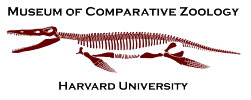Aves - Neognathae - Columbiformes - Columbidae - †Raphus - †Raphus cucullatus
Cranium (Skull) of a †Raphus cucullatus (†Dodo)
Rotate: left click on mouse
Zoom: right click on mouse (PC) or command and click (Mac)
Move: left and right click simultaneously (PC) or shift and click (Mac)
| Species Description |
|---|
|
Early drawings of the dodo depict a plump bird, roughly the size of a turkey, weighing approximately 50 lbs. and standing about three feet tall. It had tiny wings, a nine-inch long hooked beak, blue-gray feathers, and short, stout, yellow legs. Contemporary accounts often describe the dodo as clumsy; the name “dodo” reflects this, as it is believed to be derived either from the Dutch word dodoor (meaning sluggard) or doudo, Portuguese for simpleton. However, we cannot say with certainty that these early reports are accurate, or that they were even taken from direct observation of birds in the wild. Before the first fossil specimens were uncovered in 1865, very few skeletal elements existed, and there are no known full specimens of the dodo (the last, held in Oxford’s Ashmolean Museum, was destroyed in a fire in 1755). Many descriptions of the dodo are believed to have come from captive specimens, where overfeeding could account for the birds large size. In fact, a recently discovered drawing from 1601 depicts a much slimmer bird, estimated to weigh only 33 lbs! The dodo was flightless, and had highly reduced wings. While most paintings show the dodo along the beach, egg nests were reportedly found inland; given this, the dodo was believed to be a forest or swamp dweller. Though its exact diet is unknown, some accounts claimed that dodos would wade into shallow pools to catch fish, while others say that the dodo subsisted primarily on the fruit of the Tambalacocque, or Dodo Tree. Contemporary accounts also reported that the dodo would frequently eat rocks – these are now believed to have aided with digestion. While the dodo was certainly used for food by Dutch sailors, and large numbers were shipped back to Europe as specimens, overhunting is not believed to have been the sole cause for the dodos extinction. A combination of habitat loss and predation by introduced species decimated an already fragile population, and accounts of live dodos in the wild are scarce starting around 1650. Recent investigations suggest that the dodo was probably extinct by 1693 at the latest, less than 100 years after its discovery. References: Hume, J.P., Martill, D.M. and Dewdne, C. (2004) Palaeobiology: Dutch diaries and the demise of the dodo. Nature 429:622. Hume, J.P. (2006) The history of the Dodo Raphus cucullatus and the penguin of Mauritius. Historical Biology 16:65-89. Livezey, B. (1993) An ecomorphological review of the dodo (Raphus cucullatus) and solitaire (Pezophaps solitaria) flightless columbiformes of the Mascarene Islands. Journal of Zoology: Proceedings of the Zoological Society of London 230:247-292. Moree, P. (1998) A concise history of Dutch Mauritius, 1598-1710. London and New York: Kegan Paul International. Owen, R. (1866) Memoir of the Dodo (Didus ineptus Linn.). London: Taylor and Francis. Owen, R. (1872) On the Dodo (Part II). Notes on the Articulated Skeleton of the Dodo (Didus ineptus, Linn.) in the British Museum. Transactions of the Zoological Society of London 7:513-525. Strickland, H.E. and Melville, A.G. (1848) The dodo and its kindred. London: Reeve, Benham and Reeve. |
| Skeletal Elements Available |
| External Links |
|---|
|
Animal Diversity Web Encyclopedia of Life Society of Vertebrate Paleontology Dodo Memoir Wikipedia Dodo Page |




